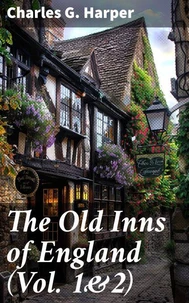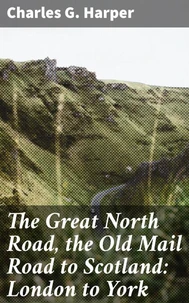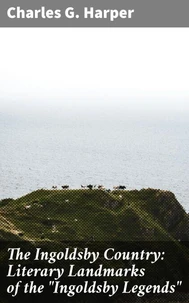The Portsmouth Road and Its Tributaries: To - Day and in Days of Old
Par :Formats :
Disponible dans votre compte client Decitre ou Furet du Nord dès validation de votre commande. Le format ePub est :
- Compatible avec une lecture sur My Vivlio (smartphone, tablette, ordinateur)
- Compatible avec une lecture sur liseuses Vivlio
- Pour les liseuses autres que Vivlio, vous devez utiliser le logiciel Adobe Digital Edition. Non compatible avec la lecture sur les liseuses Kindle, Remarkable et Sony
 , qui est-ce ?
, qui est-ce ?Notre partenaire de plateforme de lecture numérique où vous retrouverez l'ensemble de vos ebooks gratuitement
Pour en savoir plus sur nos ebooks, consultez notre aide en ligne ici
- Nombre de pages230
- FormatePub
- ISBN859-65--4723568-2
- EAN8596547235682
- Date de parution04/09/2022
- Protection num.Digital Watermarking
- Taille5 Mo
- Infos supplémentairesepub
- ÉditeurDIGICAT
Résumé
In "The Portsmouth Road and Its Tributaries: To-Day and in Days of Old, " Charles G. Harper embarks on a vivid exploration of an iconic thoroughfare, unraveling its historical significance and cultural landscape. Harper's prose elegantly weaves together narrative and description, offering readers an engaging account infused with anecdotal evidence and rich illustrations that enliven the text. This comprehensive work reflects the Victorian era's preoccupation with travel and nostalgia, serving not only as a guidebook but also as a social commentary on the evolution of England's roadways from pastoral pathways to bustling routes.
Charles G. Harper was a multifaceted artist and author, driven by a profound appreciation for the landscapes of Britain. His background in illustration and literature intersected perfectly, allowing him to capture both the aesthetic and historical facets of the Portsmouth Road. A passionate advocate for the preservation of cultural heritage, Harper's perspective was shaped by his extensive travels, instilling in him an admiration for the intersections of history and modernity.
Harper's "The Portsmouth Road and Its Tributaries" is an essential read for those fascinated by transport history, geography, and the intermingling of past and present. It beckons enthusiasts of travel writing, historians, and anyone intrigued by the unearthing of England's stories, inviting readers to traverse not only the physical journey of the road but also its rich tapestry of human experiences.
Charles G. Harper was a multifaceted artist and author, driven by a profound appreciation for the landscapes of Britain. His background in illustration and literature intersected perfectly, allowing him to capture both the aesthetic and historical facets of the Portsmouth Road. A passionate advocate for the preservation of cultural heritage, Harper's perspective was shaped by his extensive travels, instilling in him an admiration for the intersections of history and modernity.
Harper's "The Portsmouth Road and Its Tributaries" is an essential read for those fascinated by transport history, geography, and the intermingling of past and present. It beckons enthusiasts of travel writing, historians, and anyone intrigued by the unearthing of England's stories, inviting readers to traverse not only the physical journey of the road but also its rich tapestry of human experiences.
In "The Portsmouth Road and Its Tributaries: To-Day and in Days of Old, " Charles G. Harper embarks on a vivid exploration of an iconic thoroughfare, unraveling its historical significance and cultural landscape. Harper's prose elegantly weaves together narrative and description, offering readers an engaging account infused with anecdotal evidence and rich illustrations that enliven the text. This comprehensive work reflects the Victorian era's preoccupation with travel and nostalgia, serving not only as a guidebook but also as a social commentary on the evolution of England's roadways from pastoral pathways to bustling routes.
Charles G. Harper was a multifaceted artist and author, driven by a profound appreciation for the landscapes of Britain. His background in illustration and literature intersected perfectly, allowing him to capture both the aesthetic and historical facets of the Portsmouth Road. A passionate advocate for the preservation of cultural heritage, Harper's perspective was shaped by his extensive travels, instilling in him an admiration for the intersections of history and modernity.
Harper's "The Portsmouth Road and Its Tributaries" is an essential read for those fascinated by transport history, geography, and the intermingling of past and present. It beckons enthusiasts of travel writing, historians, and anyone intrigued by the unearthing of England's stories, inviting readers to traverse not only the physical journey of the road but also its rich tapestry of human experiences.
Charles G. Harper was a multifaceted artist and author, driven by a profound appreciation for the landscapes of Britain. His background in illustration and literature intersected perfectly, allowing him to capture both the aesthetic and historical facets of the Portsmouth Road. A passionate advocate for the preservation of cultural heritage, Harper's perspective was shaped by his extensive travels, instilling in him an admiration for the intersections of history and modernity.
Harper's "The Portsmouth Road and Its Tributaries" is an essential read for those fascinated by transport history, geography, and the intermingling of past and present. It beckons enthusiasts of travel writing, historians, and anyone intrigued by the unearthing of England's stories, inviting readers to traverse not only the physical journey of the road but also its rich tapestry of human experiences.







